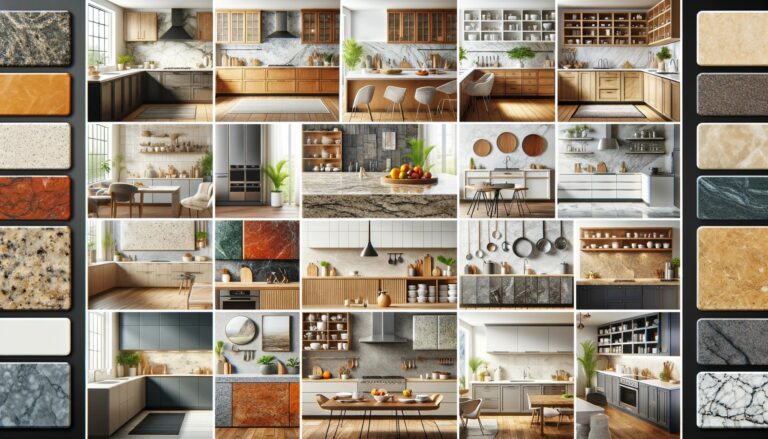
Kitchen work counters, also known as countertops, play a pivotal role in the functionality and aesthetics of any kitchen. They serve as the workhorse for food preparation, dining, and often become a gathering spot in the home. The material you choose for your countertop can significantly affect your kitchen’s appearance, usability, and maintenance level. Here’s an overview of the most popular types of kitchen work counters, highlighting their features, benefits, and considerations.
1. Granite Countertops
- Features: Each slab is unique, offering rich colours and natural patterns.
- Benefits: Durable, heat-resistant, and adds value to your home.
- Considerations: Requires periodic sealing to resist stains and can be expensive.
2. Quartz Countertops
- Features: Engineered from quartz particles and resin, available in a wide range of colours and patterns.
- Benefits: Non-porous, low maintenance, and doesn’t require sealing.
- Considerations: Can be costly and less heat-resistant compared to natural stone.
3. Laminate Countertops
- Features: Composed of a plastic laminate surface bonded to a particleboard core.
- Benefits: Cost-effective, easy to clean, and available in various colours and designs.
- Considerations: Susceptible to scratches, cuts, and heat damage.
4. Marble Countertops
- Features: Known for their veining and rich aesthetic.
- Benefits: Adds a luxurious touch, excellent for baking preparation surfaces.
- Considerations: Porous nature requires regular sealing, prone to staining and scratching.
5. Butcher Block (Wood) Countertops
- Features: Made from straight cuts of wood glued together for strength.
- Benefits: Warm aesthetic, can be sanded and refinished.
- Considerations: Requires regular maintenance with oil, can be damaged by water and heat.
6. Stainless Steel Countertops
- Features: Offers a sleek, industrial look.
- Benefits: Heat resistant, hygienic, and durable.
- Considerations: Can dent and scratch more easily than stone countertops.
7. Concrete Countertops
- Features: Customizable in shape, colour, and finish.
- Benefits: Extremely durable, heat and scratch-resistant.
- Considerations: Very heavy, requiring reinforced cabinetry; porous and requires sealing.
8. Soapstone Countertops
- Features: Natural stone with a smooth, matte feel.
- Benefits: Non-porous, resistant to staining, and does not require sealing.
- Considerations: Limited colour range, can scratch and chip; develops a patina over time.
9. Ceramic Tile Countertops
- Features: Offers limitless design options with tiles.
- Benefits: Heat and stain-resistant, damaged tiles can be replaced.
- Considerations: Grout lines can stain and require maintenance; uneven surface.
10. Recycled Glass Countertops
- Features: Made with pieces of recycled glass in a resin base.
- Benefits: Unique appearance, eco-friendly, and durable.
- Considerations: Can be expensive and may show fingerprints and smudges.
Conclusion
Choosing the right kitchen countertop material involves balancing aesthetics, functionality, and budget. Each type offers unique characteristics and benefits, so consider your kitchen habits, maintenance preferences, and overall design theme when making a decision. It’s also advisable to view and feel the materials in person and consult with a kitchen design professional to ensure your chosen countertop aligns with your kitchen renovation goals.